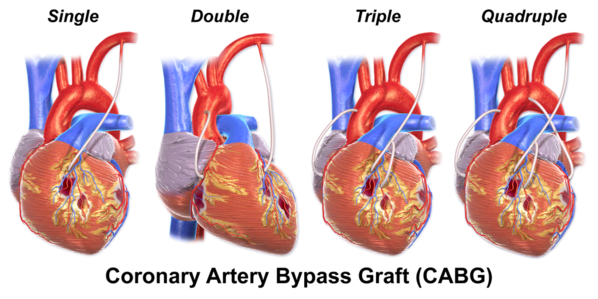
What is Coronary Artery Bypass Grafting (CABG)?
Coronary Artery Bypass Grafting (CABG), commonly known as heart bypass surgery, is a type of surgery used to treat coronary artery disease (CAD). CAD occurs when the coronary arteries, which supply blood to the heart muscle, become narrowed or blocked due to the buildup of plaque (atherosclerosis). This can restrict blood flow and oxygen to the heart, potentially leading to chest pain (angina) or a heart attack.
CABG involves creating new pathways (bypasses) around the blocked arteries to restore proper blood flow to the heart.
How Does CABG Work?
-
Procedure Overview
During the CABG surgery, a surgeon uses a healthy blood vessel from another part of the body, such as the leg (saphenous vein), arm (radial artery), or chest (internal mammary artery), to bypass the blocked or narrowed coronary artery. This allows blood to flow more easily to the heart muscle. -
Types of CABG
-
Traditional CABG: This procedure is performed with the patient under general anesthesia. A large incision is made in the chest to access the heart. The heart may be temporarily stopped while the bypass grafts are placed.
-
Off-pump CABG: This variation is done while the heart is still beating, and a special device is used to stabilize the part of the heart being operated on.
-
Minimally Invasive CABG: In some cases, smaller incisions may be made, and the procedure may be performed using robotic assistance or other techniques to reduce recovery time.
-
-
Grafts Used
The surgeon will use blood vessels from the patient’s own body (autografts) to create the bypass. Common grafts include:-
Internal Mammary Artery (IMA): Often preferred due to its long-term success rates.
-
Saphenous Vein: Typically taken from the leg.
-
Radial Artery: Taken from the arm in some cases.
-
Why is CABG Performed?
CABG is typically recommended when:
-
Angina (chest pain) is severe and cannot be controlled by medications.
-
Heart attack risk is high due to blocked arteries.
-
Coronary artery blockage cannot be treated effectively by angioplasty or stents.
-
The blockage is located in areas of the heart that are difficult to treat with less invasive methods.
CABG can relieve symptoms, improve heart function, and reduce the risk of heart attack, potentially prolonging life in patients with advanced coronary artery disease.
What to Expect Before, During, and After CABG Surgery
Before the Surgery:
-
You will undergo a series of tests to assess the condition of your heart and blood vessels. These may include blood tests, a chest X-ray, and an electrocardiogram (ECG).
-
The surgeon will discuss the procedure, including the type of grafts to be used, and any specific risks or concerns.
During the Surgery:
-
The procedure typically lasts 3-6 hours.
-
You will be under general anesthesia, and the heart may be temporarily stopped to allow the surgeon to perform the bypasses.
After the Surgery:
-
You will be monitored in a recovery room (intensive care unit or ICU) for several days.
-
Most patients stay in the hospital for 5-7 days after the procedure.
-
Recovery times vary, but it can take 6-12 weeks for a full recovery, during which physical activity is gradually reintroduced.
Postoperative Care:
-
You will be prescribed medications, including blood thinners and pain relievers.
-
Lifestyle changes, such as adopting a heart-healthy diet, regular exercise, and stress management, will be essential for long-term heart health.
Potential Risks and Complications
Like any major surgery, CABG comes with some risks, including:
-
Infection
-
Bleeding
-
Stroke
-
Heart attack
-
Graft failure
However, CABG is generally a safe procedure, and its benefits in improving blood flow to the heart often outweigh the risks for patients with severe coronary artery disease.
Benefits of CABG
CABG can offer significant long-term benefits, including:
-
Relief from chest pain (angina) and improved heart function.
-
Improved quality of life by allowing more physical activity without discomfort.
-
Reduced risk of heart attack or other serious heart complications.
-
Increased life expectancy for patients with severe coronary artery disease.